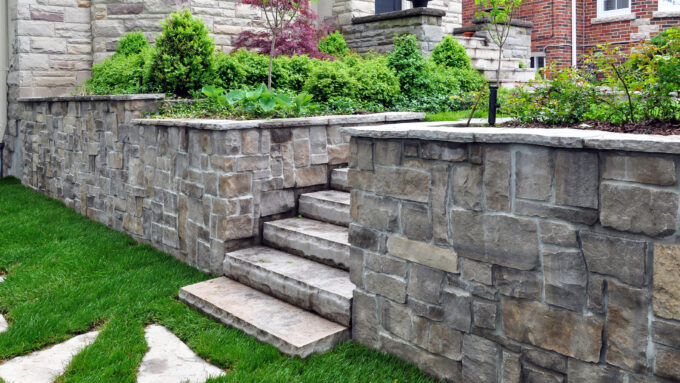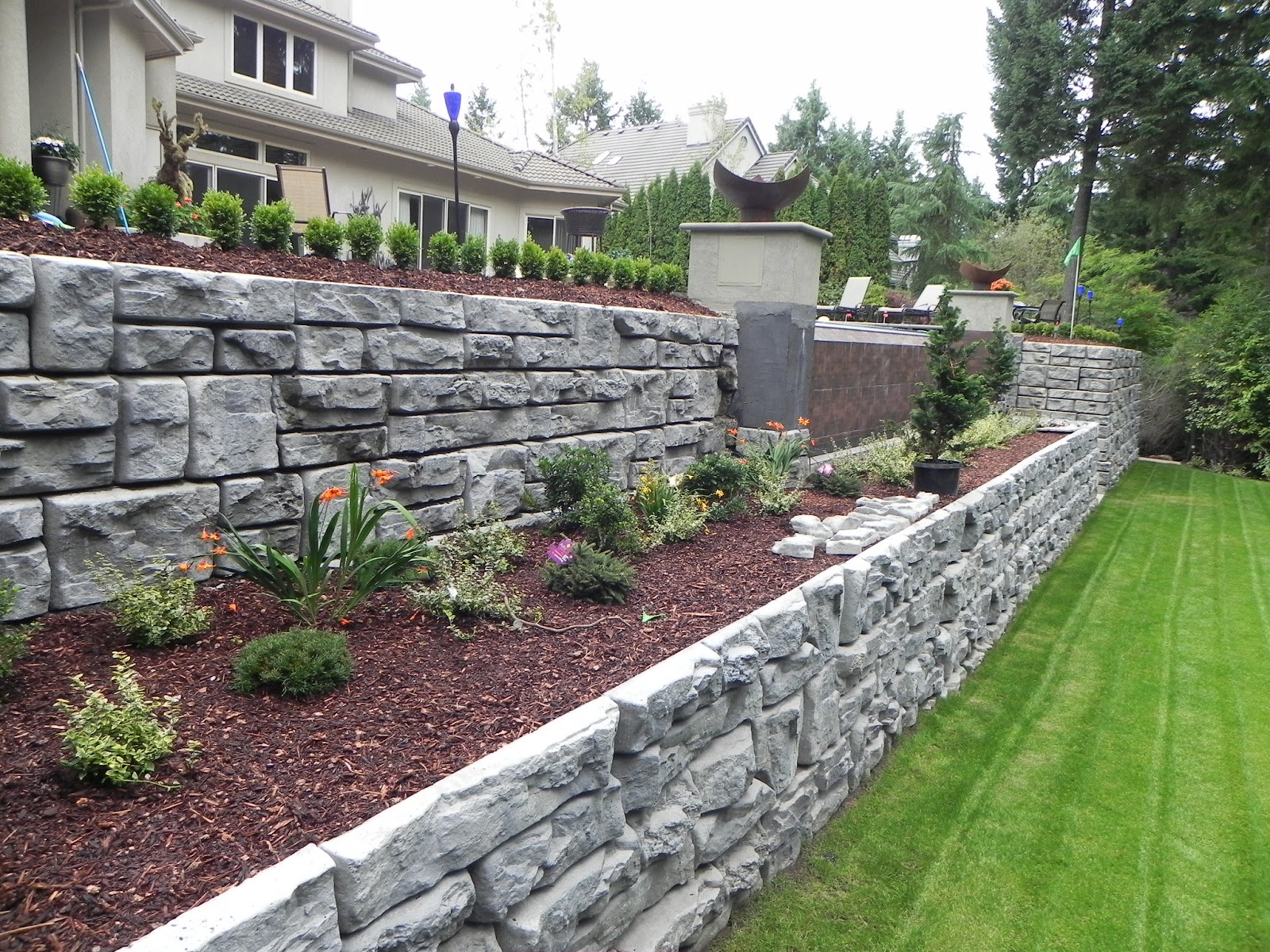Making Certain Architectural Stability: The Relevance of Appropriately Constructed Keeping Wall Surfaces in Protecting Against Incline Failure
In the world of civil design and building, the value of appropriately created maintaining walls in preventing slope failing can not be underrated. By discovering the detailed interplay between these aspects, a deeper understanding of the pivotal duty that keeping wall surfaces play in protecting architectural integrity and stopping incline failure emerges.
Role of Retaining Walls in Stability
The indispensability of maintaining wall surfaces in making certain incline stability is paramount in civil design techniques. Keeping walls offer a vital role in protecting against dirt erosion, handling water runoff, and preserving the architectural integrity of inclines. By sustaining upright or near-vertical quality adjustments, maintaining wall surfaces aid to redistribute side stress exerted by the dirt, thus minimizing the risk of incline failing.
One key feature of keeping walls is to counteract the force of gravity acting on the soil mass behind them. This is achieved with correct style and building and construction, which takes into consideration elements such as dirt type, wall height, drain stipulations, and prospective surcharge loads. By properly keeping dirt within specified boundaries, these structures aid to support inclines and protect against landslides.
Moreover, keeping walls add to the visual appeals of landscapes while offering practical advantages. They can produce terraced levels for landscaping, assistance streets or frameworks on hills, and improve the overall usability of sloped surface. In essence, maintaining wall surfaces play a crucial role in preserving slope stability and guaranteeing the security and long life of civil design projects.
Factors Affecting Wall Performance
Factors that influence the efficiency of preserving walls include soil residential properties, wall design, and external tons. Soil buildings play a crucial role in figuring out the stability and performance of a maintaining wall surface. Variables such as dirt kind, communication, interior friction angle, and groundwater problems can impact how well a wall retains the soil behind it. The style of the retaining wall is one more key element that affects its performance. Appropriate wall design thinks about variables like wall surface elevation, wall surface type (e.g., gravity walls, cantilever wall surfaces), reinforcement materials, drain systems, and building and construction strategies to make certain the wall can stand up to the lateral pressure exerted by the preserved soil. In addition, exterior loads, such as surcharge loads from adjacent structures or website traffic, seismic pressures, and water pressure, should be very carefully reviewed during the design and construction phases to ensure the wall can adequately resist these external forces. By considering these aspects adequately, engineers can construct maintaining wall surfaces that efficiently protect against slope failure and guarantee long-lasting structural honesty.
Layout Factors To Consider for Retaining Walls
Including the critical elements of soil buildings and exterior lots right into the architectural style procedure is necessary for establishing effective retaining wall surfaces that make sure incline stability. When designing retaining walls, designers should thoroughly examine the qualities of the surrounding dirt, including its kind, drain, and compaction buildings. Comprehending these soil residential or commercial properties is essential for determining the proper wall density, news support, and height needed to hold up against the side stress exerted by the dirt mass.
Moreover, outside tons such as additional charge tons from nearby structures or website traffic, in addition to seismic pressures, should be thought about throughout the design stage. These tons can substantially impact the security and efficiency of a maintaining wall surface, requiring using appropriate layout techniques and products to reduce prospective failing threats.
Furthermore, the option of appropriate products, such as concrete, stone, or lumber, ought to straighten with the site-specific problems and visual demands. Variable of safety factors to consider, drainage arrangements, and construction methods are additionally crucial elements that affect the general design and functionality of maintaining wall surfaces in stopping incline failing. By thoroughly thinking about these style considerations, engineers can make certain the architectural integrity and long-term stability of preserving wall surfaces.

Construction Best Practices for Toughness
When creating preserving wall surfaces for optimal longevity and long life, adherence to industry-standard methods and careful attention to detail are vital. To make sure the resilience of a preserving wall, appropriate website preparation is crucial. This includes ample compaction of the soil, correct drain systems, and making sure the wall's foundation is sound. Utilizing premium products, such as concrete blocks or all-natural stone, is vital for the longevity of the structure. In addition, using competent professionals with experience in creating retaining wall surfaces can considerably affect the longevity of the end product.
Integrating support techniques, such as geogrids or steel bars, can improve the architectural stability of the preserving wall and stop possible failings. Correct backfilling procedures, including compaction and water drainage considerations, are additionally vital for the wall's toughness. Regular maintenance and inspections are suggested to resolve any kind of signs of wear, erosion, or architectural problems promptly. By complying with these building and construction finest techniques, keeping walls can withstand the test of time and successfully prevent incline failure.
Relevance of Correct Maintenance
Regular maintenance is necessary for protecting the architectural honesty and capability of retaining wall surfaces over time. To guarantee that retaining walls proceed to execute their intended feature efficiently, regular examinations ought to be performed to identify any type of signs of wear and tear.

Conclusion
To conclude, maintaining wall surfaces play a crucial function in making sure architectural stability and protecting against slope failure. By thinking about aspects affecting wall performance, adhering to create considerations, complying with construction ideal techniques, and applying correct maintenance, the toughness of maintaining wall surfaces can be maximized. Retaining Walls Sunshine Coast. It is important to identify the value of effectively created maintaining wall surfaces in maintaining security and protecting against possible risks connected with slope failing
Elements that affect the effectiveness of retaining wall surfaces include dirt residential or commercial properties, wall style, and outside tons. Correct wall surface design takes into consideration elements like wall elevation, wall type (e.g., gravity walls, cantilever walls), reinforcement products, drain systems, and building and construction methods to make sure the wall can withstand the lateral stress put in by the preserved dirt. By thinking about these aspects comprehensively, designers can construct maintaining walls that efficiently prevent slope failing and make sure long-term architectural integrity.
Upkeep jobs may consist of removing water drainage systems to avoid water build-up behind the wall, repairing any type of visible cracks or damage, and guaranteeing that the wall is free from plants that could exert pressure on the structure. By taking into consideration variables affecting wall surface performance, sticking to create considerations, following building best techniques, and executing proper upkeep, the resilience of preserving walls can be taken full advantage of.